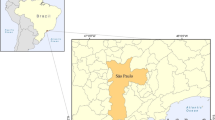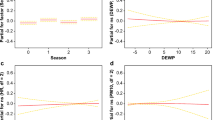Abstract
The current study investigated the correlation between stroke mortality and temperature. Monthly and seasonal variations in stroke mortality were plotted and daily stroke-related deaths were calculated. The lag times were calculated using the time series analysis. The correlation between stroke incidence and the diurnal temperature range (DTR) was analyzed using case-crossover analysis. Global stroke mortality was described in five latitudes. In the eastern region of Inner Mongolia, the stroke mortality was 174.18/105, about twice of that of the midwestern regions (87.07/105), and temperature was negatively correlated with stroke mortality. Mortality peaked in the winter and troughed in the summer (χ2 = 13.634, P < 0.001). The days in which stroke-related deaths were greater than ten occurred between late October and early April. The effect of temperature on stroke incidence occurred during a lag time of 1 (P = 0.024) or 2 months (P = 0.039). A DTR over 13 °C was positively correlated (r = 0.95, P = 0.004) with stroke with a lag time of 1 day. The effect of temperature on stroke was shown to be the same for various populations. As the latitude increases, stroke mortality also increases with latitudes > 40°; the highest mortality was 188.05/105 at the highest latitude. Only in relatively cold regions as the temperature decreases does stroke mortality increase for various populations. Differences in the time lag as well as in the DTR lag and DTR critical point vary for both the temperature and region.




Similar content being viewed by others
References
Alperovitch A, Lacombe JO, Dartigues J, Ritchie K, Ducimetiere P, Tzourio C (2009) Relationship between blood pressure and outdoor temperature in a large sample of elderly individuals: the three-city study. Arch Intern Med 169(1):75
Alter M, Christoferson L, Resch J, Myers G, Ford J (1970) Cerebrovascular disease: frequency and population selectivity in an upper midwestern community. Stroke 1(6):454–465
Analitis A, Katsouyanni K, Biggeri A, Baccini M, Forsberg B, Bisanti L, Kirchmayer U, Ballester F, Cadum E, Goodman PG, Hojs A, Sunyer J, Tiittanen P, Michelozzi P (2008) Effects of cold weather on mortality: results from 15 European cities within the PHEWE project. Am J Epidemiol 168(12):1397–1408
Barnett AG (2007) Temperature and cardiovascular deaths in the US elderly: changes over time. Epidemiology 18(3):369–372
Bi SZ, Chen JH, Yuan FS (2012) Study of the relationship between air temperature and stroke in Changzhi area. Zhongguo Wei Zhong Bing Ji Jiu Yi Xue 24(9):556
Bull GM, Brozovic M, Chakrabarti R, Meade TW, Morton J, North WR et al (1979) Relationship of air temperature to various chemical, haematological, and haemostatic variables. J Clin Pathol 32(1):16–20
Capon A, Demeurisse G, Zheng L (1992) Seasonal variation of cerebral hemorrhage in 236 consecutive cases in Brussels. Stroke 23(1):24–27
Chen G, Zhang Y, Song G, Jiang L, Zhao N, Chen B, Kan H (2007) Is diurnal temperature range a risk factor for acute stroke death? Int J Cardiol 116(3):408–409
Chen XQ, Peng JD, Hui-Min LI (2009) Seasonal and regional differences of air temperature changes in Inner Mongolia. Geogr Res 28(1):27–35
Chyatte D, Chen TL, Bronstein K, Brass LM (1994) Seasonal fluctuation in the incidence of intracranial aneurysm rupture and its relationship to changing climatic conditions. J Neurosurg 81(4):525–530
Connor MD (2002) Does the weather influence stroke incidence? Stroke 33(7):1751–1758
Dawson J, Quinn T, Walters MR (2010) Under the weather with stroke; more data emerge. Int J Stroke 4(1):19–20
Díaz J, García R, López C, Linares C, Tobías A, Prieto L (2005) Mortality impact of extreme winter temperatures. Int J Biometeorol 49(3):179–183
Donaldson G (1997) Cold exposure and winter mortality from ischaemic heart disease, cerebrovascular disease, respiratory disease, and all causes in warm and cold regions of Europe. The Eurowinter group. Lancet 349(9062):1341–1346
Easterling DR, Horton B, Jones PD, Peterson TC, Karl TR, Parker DE, et al (1997). Maximum and minimum temperature trends for theglobe.Science, 277(5324):364-367
Goggins WB, Woo J, Ho S, Chan EY, Chau PH (2012) Weather, season, and daily stroke admissions in Hong Kong. Int J Biometeorol 56(5):865-872
Hong YC, Rha JH, Lee JT, Ha EH, Kwon HJ, Kim H (2003) Ischemic stroke associated with decrease in temperature. Epidemiology 14(4):473–478
Inner Mongolian Autonomous Regional Bureau of Statistics (2010) Inner Mongolia Statistical Yearbook 2009. Inner Mongolian, China
Inner Mongolian Autonomous Regional Bureau of Statistics (2011) Inner Mongolia Statistical Yearbook 2010. Inner Mongolian, China
Inner Mongolian Autonomous Regional Bureau of Statistics (2012) Inner Mongolia Statistical Yearbook 2011. Inner Mongolian, China
Kannel WB, Gordon T, Schwartz MJ (1971) Systolic versus diastolic blood pressure and risk of coronary heart disease. The Framingham study. Am J Cardiol 27(4):335–346
Keatinge WR, Coleshaw SRK, Cotter F, Mattock MB, Murphy M, Chelliah R (1984) Increase in platelet and red cell counts, blood viscosity, and arterial pressure during mild surface cooling: factors in mortality from coronary and cerebral thrombosis in winter. Br Med J 289(6456):1405–1408
Kim AS, Johnston SC (2011) Global variation in the relative burden of stroke and ischemic heart disease. Circulation 124(3):314–323
Kyobutungi C, Grau A, Stieglbauer G, Becher H (2005) Absolute temperature, temperature changes and stroke risk: a case-crossover study. Eur J Epidemiol 20(8):693–698
Lanska DJ, Hoffmann RG (1999) Seasonal variation in stroke mortality rates. Neurology 52(5):984–990
Lichtman JH, Leifheit-Limson EC, Jones SB, Wang Y, Goldstein LB (2016) Average temperature, diurnal temperature variation, and stroke hospitalizations. J Stroke Cerebrovasc Dis 25:1489–1494
Liu M, Wu B, Wang W-Z, Lee L-M, Zhang S-H, Kong L-Z (2007) Stroke in China: epidemiology, prevention, and management strategies. Lancet Neurol 6:456–464
Matsumoto M, Ishikawa S, Kajii E (2010) Cumulative effects of weather on stroke incidence: a multi-community cohort study in Japan. J Epidemiol 20(2):136–142
Morabito M, Crisci A, Vallorani R, Modesti PA, Gensini GF, Orlandini S (2011) Innovative approaches helpful to enhance knowledge on weather-related stroke events over a wide geographical area and a large population. Stroke 42(3):593–600
Mostofsky E, Wilker EH, Schwartz J, Zanobetti A, Gold DR, Wellenius GA, Mittleman MA (2014) Short-term changes in ambient temperature and risk of ischemic stroke. Cerebrovasc Dis Extra 4(1):9–18
Myint PK, Vowler SL, Woodhouse PR, Redmayne O, Fulcher RA (2007) Winter excess in hospital admissions, in-patient mortality and length of acute hospital stay in stroke: a hospital database study over six seasonal years in Norfolk, UK. Neuroepidemiology 28(2):79–85
Pasqualetti P, Natali G, Casale R, Colantonio D (1990) Epidemiological chronorisk of stroke. Acta Neurol Scand 81(1):71–74
Phung D, Guo Y, Thai P, Rutherford S, Wang X, Nguyen M, Do CM, Nguyen NH, Alam N, Chu C (2016) The effects of high temperature on cardiovascular admissions in the most populous tropical city in Vietnam. Environ Pollut 208(2015):33–39
Talbot S (1973) Epidemiological features of subarachnoid and cerebral haemorrhages. Postgrad Med J 49(571):300–304
Tam WWS, Tzewai W, Chair SY, Wong AHS (2009) Diurnal temperature range and daily cardiovascular mortalities among the elderly in Hong Kong. Arch Environ Occup Health 64(3):202–206
Tian X, Zhang Y, Gu S, Fan Y, Sun Q, Zhang B et al (2014) New coxsackievirus b4 genotype circulating in Inner Mongolia autonomous region, China. Plos One 9(3):e90379
Wang K, Li H, Liu W, You C (2013) Seasonal variation in spontaneous intracerebral hemorrhage frequency in Chengdu, China, is independent of conventional risk factors. J Clin Neurosci 20(4):565–569
Wang X, Cao Y, Hong D, Zheng D, Richtering S, Sandset EC et al (2016) Ambient temperature and stroke occurrence: a systematic review and meta-analysis. Int J Environ Res Public Health 13(7)
WHO (2002). http://www.who.int/cardiovascular-diseases/resources/atlas/en/. Accessed 2002
Xin KP, Du ML, Li ZJ, Li Y, Li W, Su X et al (2014a) Mortality of urinary tract cancer in Inner Mongolia 2008–2012. Asian Pac J Cancer Prev 15(6):2831–2834
Xin KP, Du ML, Liu ZY, Wang WR, Qian YG, Liu L et al (2014b) Colorectal cancer mortality in Inner Mongolia between 2008 and 2012. World J Gastroenterol 20(25):8209–8214
Yang W, Levi CR, Attia JR, D’Este CA, Spratt N, Fisher J (2003) Seasonal variation in stroke in the hunter region, Australia. Stroke 34(5):1144–1150
Yang J, Peng Y, Zhou M, Ou CQ, Li M, Jing L et al (2016) The burden of stroke mortality attributable to cold and hot ambient temperatures: epidemiological evidence from China. Environ Int 92-93:232–238
Funding
The study was supported by the Inner Mongolia Medical University Students Innovation and Entrepreneurship Program Training Project Autonomous Region. (No. 201810132010) and the Natural Science Foundation of Inner Mongolia in China (No. 2013MS1124).
Author information
Authors and Affiliations
Corresponding author
Ethics declarations
Conflict of interest
The authors declare that they have no competing interests.
Additional information
This manuscript has been thoroughly edited by a native English speaker from an editing company. Editing certificate will be provided upon request.
Electronic supplementary material
ESM 1
(DOCX 229 kb)
Rights and permissions
About this article
Cite this article
Guo, W., Du, M., Sun, D. et al. The effect characteristics of temperature on stroke mortality in Inner Mongolia and globally. Int J Biometeorol 63, 159–166 (2019). https://doi.org/10.1007/s00484-018-1647-7
Received:
Revised:
Accepted:
Published:
Issue Date:
DOI: https://doi.org/10.1007/s00484-018-1647-7




